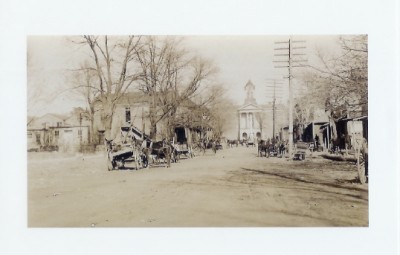
New Post has been published on http://www.hottytoddy.com/ole-miss-notes-from-the-past-2/
Ole Miss Notes from the Past

Previous blogs have discussed the 46 places nominated as possible homes for the University of Mississippi and the process for finally selecting Oxford. Except for counties in the Mississippi Delta, a place from most of the counties was put in nomination—from Tishomingo to Hancock. Although eight of the places (Barefoot, Quincy, City of Pearl, Jackson, Cud-de-hunk (Cutty Hunk), Lexington, Mount Pleasant, and Natchez) received no votes after the formal balloting began (the law provided that “not more than one point in each county shall be placed in nomination”), clearly a number of places would have been suitable sites.
Of the cities or towns nominated in 1840, a number are still reasonably large, at least by Mississippi standards, with populations of 10,000 or higher: Jackson, Columbus, Starkville, Natchez, Brandon, Oxford, and Grenada. Several others, with populations from less than 500 to approximately 8,000 are still active (and the population is increasing in some of them): Philadelphia, Holly Springs, Louisville, Kosciusko, Lexington, Raymond, Monticello, DeKalb, and Good Springs (Tishomingo).
Fewer than twenty of the places, then, are highly populated areas today. Some authorities have named fifteen of the places as being extinct: Augusta, Brandywine, Emory, Gallatin, Greeensboro, Holmesville, Kingston, Middleton, Pearl, Pinckney, Salem, Van Buren, Warrenton, Westville, and Winchester. In addition, another writer includes Hillsboro, Mt. Pleasant, and Paulding in a list of declining small towns in Mississippi.
Depending on one’s definition, Barefoot, Cuddy Hunk, Magnolia, Mississippi City, Monroe Missionary Station, Mount Carmel, Quincy, Red Bone, Sharon, Summerville, Sweet Water, and Thomaston might be added to the list of extinct villages or villages which have declined in size and/or activity.
Jackson, Columbus, Starkville, Oxford, and Raymond (of the places nominated, only Raymond became the home for a community college) have proven to be highly satisfactory homes for institutions of higher learning.
Might other places have been equally satisfactory? Had the state university been located at, let us say, Van Buren, Middleton, Magnolia, or Holmesville, would those villages now be thriving towns or cities rather than extinct communities? Might there still be hotels and physicians’ offices (and dormitories and libraries) in places where cattle graze or forests grow or farmers cultivate their crops? If the university had been established at a place–like Kosciusko or Thomastown–in the center of the state, would the state system now consist of eight universities throughout the state?
If the university had been located at the capital in Jackson, would there still have been other universities located in other parts of the state? It is interesting to speculate about where legislators would have placed a college or university for African Americans if doing that had been a consideration.
Perhaps just as interesting is the question of whether there would now be an Alcorn State University at Lorman, a Jackson State University at Jackson (or at Natchez, where the school began), or a Mississippi Valley State University at Itta Bena had integration taken place 50 years earlier.
If the University of Mississippi had admitted women before 1882, would Mississippi University for Women have been established, or was it inevitable that there would be a women’s college formed in the state? Would the University of Southern Mississippi at Hattiesburg and Delta State University at Cleveland, which began as “normal” schools, have been established regardless of where the state university had been located?
If the City of Pearl or Mississippi City had been selected, there would have been no twenty-first century law suits about a senior college offering lower-level classes on the Gulf Coast; but how long would it have been before another university would have been located in the central or northern part of the state?
The success of Mississippi State University as a land-grant institution causes one to wonder whether the state would now have comprehensive universities at Jackson, Hattiesburg, and Oxford if Starkville had been chosen as the location for the university in 1841. If the railroad (not very important at a time when students travel by plane or car, but very important in the early days of the University) had bypassed Oxford, or if the county seat had been moved to another place in Lafayette County, would Oxford be the delightful University town it is today?
(Sometimes I imagine what might have been: A sports announcer on ESPN says something like “And we come to you today from the Ole Miss Vaught-Hemingway Stadium located in beautiful downtown Cutty Hunk, Mississippi.”)
via Tumblr http://hottytoddynews.tumblr.com/post/51005548413


No comments:
Post a Comment